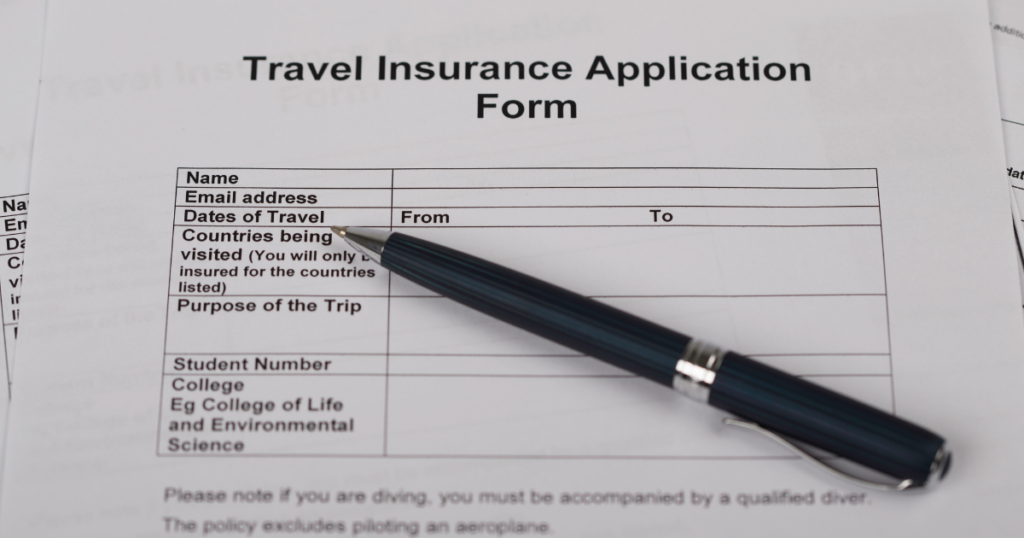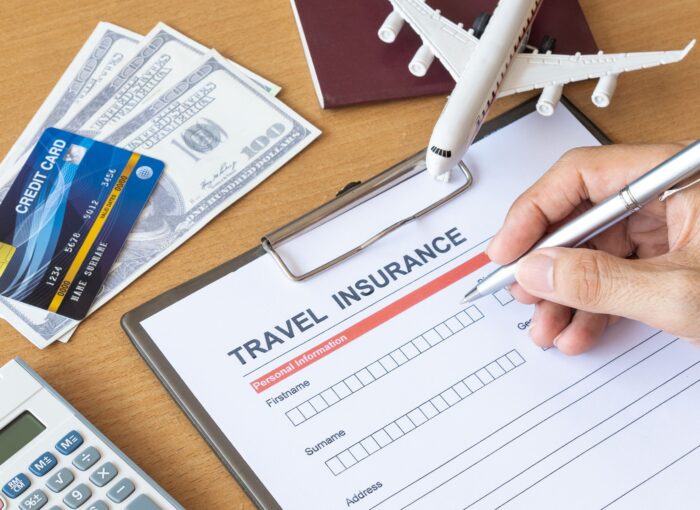Let’s talk about the less glamorous but utterly essential part of your travel planning—travel insurance! 🌍 Whether you’re skydiving in Dubai or sipping chai in Chiang Mai, unexpected events can happen. And while we all hope for smooth sailing (or flying!), travel insurance can be the safety net that makes or breaks a trip. So, grab your imaginary glasses, and let’s get schooled on keeping your adventures worry-free!

Understanding the Basics: What Is Travel Insurance?
Travel insurance is like that friend who always has band-aids and snacks; you might not always need them, but boy, are you grateful when you do! Before you pack your bags and set your out-of-office email, let’s dive into the nitty-gritty of travel insurance. Imagine having a safety net underneath your tightrope as you walk the precarious line between planning the perfect trip and everything that can go wrong. That’s travel insurance for you!
What Exactly Is Travel Insurance?
Travel insurance is essentially a backup plan for your journey, designed to protect you against the unforeseen and often inconvenient realities of traveling. It’s a specific type of insurance that covers you from the moment you step out the door to the moment you return home. The idea is to offer peace of mind by covering financial losses caused by a wide range of travel-related incidents, such as cancellations, medical emergencies, or even lost luggage.
Why Consider Travel Insurance?
Think of travel insurance as your travel guardian angel. It hovers in the background, ready to save the day if something goes wrong. Here’s why you might consider it:
- Unexpected Cancellations: You’ve planned everything, but suddenly, you need to cancel because you, a family member, or a travel companion gets sick.
- Medical Emergencies: Medical treatments abroad can be expensive, and your regular health insurance may not cover medical costs overseas.
- Loss or Theft: Losing your luggage or having your belongings stolen can turn any trip sour. Travel insurance can cover the loss and help you replace what’s missing.
- Peace of Mind: Above all, travel insurance provides reassurance. Knowing you’re covered can help you relax and enjoy your trip more fully.
Common Coverage Areas
While policies vary widely, most travel insurance plans cover several basic areas:
- Trip Cancellation/Interruption: If you need to cancel your trip due to unforeseen circumstances (like illness or a family emergency) or cut it short, this coverage can reimburse pre-paid, non-refundable travel expenses.
- Medical: From a doctor’s visit for a bad flu to hospitalization for more severe conditions, medical coverage ensures you’re not left paying a fortune in out-of-hospital bills.
- Emergency Evacuation: In cases of serious illness or disaster, emergency evacuation coverage ensures you can get home safely and without bearing the astronomical costs.
- Baggage and Personal Effects: Whether your bag decides to take a different vacation or your camera disappears, this coverage can help replace your belongings and cover the costs.
- 24-Hour Assistance: Many plans include a 24/7 hotline to help with everything from medical emergencies to lost passports.
It’s Not a One-Size-Fits-All
Your perfect travel insurance plan depends on your trip type, destination, length of travel, and what kinds of activities you’ll be engaging in. For instance, if you plan to go skiing in Switzerland, ensure that your policy covers sports injuries and related risks.
By understanding the basics of what travel insurance is and why it might be necessary, you can better navigate the choices available and find the coverage that best matches your travel needs. Think of it as buckling your seatbelt—it’s a simple step that offers critical protection as you embark on your adventures.

Choosing the Right Plan: Tailor-Made for Your Travels
Selecting the right travel insurance plan isn’t just about checking off a box on your travel to-do list; it’s about crafting a personal safety net that fits the unique contours of your adventure. Just like you wouldn’t wear flip-flops for a hike in the Himalayas, you shouldn’t choose a travel insurance plan that doesn’t fit your trip. Here’s how to match your insurance with your itinerary, ensuring you’re covered exactly where and how you need to be.
Consider Your Destination
Different destinations may require different types of coverage. For example, if you’re traveling to a remote island or a country with high medical costs, like the USA, ensure your plan offers comprehensive medical coverage and emergency evacuation. Countries with volatile weather or political climates might necessitate more robust cancellation coverage.
Assess the Length and Cost of Your Trip
The length of your journey and the overall cost will play significant roles in determining the extent of coverage you need. Longer trips often require more comprehensive plans, which can cover everything from trip interruptions to unexpected medical expenses. Also, the more you’ve invested in your trip upfront, the more you stand to lose, making trip cancellation and interruption insurance even more crucial.
Identify Your Activities
Are you planning to bungee jump in New Zealand or ski in the Alps? Activities deemed “high risk” often require additional coverage not included in standard policies. Check the fine print to ensure your adventures are covered. After all, it’s no fun being told your scuba diving accident isn’t covered after the fact!
Know Your Health and Travel Companions
Your personal health and who you travel with can influence your insurance needs. Older travelers or those with pre-existing conditions will likely need more comprehensive medical coverage. Similarly, if you’re traveling with family, you might want a policy that covers everyone under one plan for added convenience and potentially lower costs.
Compare and Contrast Policies
Don’t just snap up the first policy you come across. Use comparison websites to view a range of insurance products side by side. Pay attention to:
- Coverage limits: Is the maximum coverage amount adequate for your needs?
- Deductibles: Higher deductibles can reduce your premiums, but mean more out-of-pocket expenses if you need to make a claim.
- Exclusions: What’s not covered? Common exclusions include pre-existing medical conditions, certain sports, and activities, or travel to high-risk countries.
- Customer reviews: What do other travelers say about their claims experience with the insurer?
Read the Fine Print
Yes, it’s the boring part, but understanding the specifics of your policy, including how to make a claim and what documentation you’ll need, is crucial. Make sure you know how to contact your insurer while abroad, and what steps to follow in the event of an emergency.
Choose a Reputable Provider
Finally, ensure your insurer has a good reputation for customer service and claim handling. An insurance plan is only as good as the service that backs it up, especially when you find yourself in a tough spot far from home.
By taking the time to carefully select a travel insurance plan that fits your specific travel needs, you’ll not only safeguard your physical and financial health but also gain peace of mind. And with that secure foundation, you’re free to explore the world with confidence and excitement.

Making Claims: No Tall Tales Here!
When the unexpected happens while you’re exploring new horizons, knowing how to efficiently file a claim on your travel insurance can turn a potential nightmare into a mere hiccup on your adventure. Here’s a straightforward guide on making claims that ensures you get the help you need without added drama.
Keep Meticulous Records
From the moment your journey begins, keep a detailed record of all your travel documents, receipts, and expenses. If an incident occurs requiring you to claim, these documents are your best allies. For example, if you need to cancel your trip last minute due to illness, having a doctor’s note and records of your trip cancellations (flights, hotels, tours, etc.) will be crucial.
Report Immediately
Whether it’s a stolen bag or a medical emergency, report the incident as soon as possible—not only to the appropriate local authorities but also to your insurance provider. Many insurers have specific time frames within which you must notify them of an incident to be eligible for coverage. Delayed reporting can complicate your claim or, worse, render it invalid.
Understand the Claims Process
Familiarize yourself with your insurer’s claims process before you travel. Knowing whom to contact and what steps to follow can save you a lot of stress when you’re in a different time zone or dealing with a local emergency. Most travel insurance companies offer 24/7 support lines—save this number in your phone and keep a written copy with your travel documents.
Collect Necessary Documentation
The type of claim you’re making will dictate the documents you need. For medical claims, gather all medical reports, bills, and receipts related to your treatment. For stolen items, you’ll need a police report filed within 24 hours of the incident and proof of ownership and value of the stolen items. For trip delays or cancellations, keep copies of all communications with airlines or travel providers, including any compensation or refunds offered.
Submit Your Claim Promptly
Once you have all your documentation, submit your claim as per the instructions provided by your insurer. Be thorough and provide all required information to avoid delays. Include a clear, concise explanation of what happened, accompanied by supporting documents. Digital platforms and apps provided by insurers can streamline this process, allowing you to upload documents and track your claim’s status online.
Follow Up
After submitting your claim, keep in touch with your insurance provider. If additional information is required, provide it promptly to keep things moving. Don’t hesitate to reach out if you think the process is taking too long—sometimes a quick call or email can expedite a response.
Be Patient but Persistent
The claims process can sometimes be slow, especially if it involves complex situations or large sums of money. Patience is key, but so is persistence. Stay on top of your claim, and ensure you receive the compensation you’re entitled to.
Filing a claim on your travel insurance might not be the most exhilarating part of your travels, but it’s a vital one. By understanding and preparing for the claims process, you ensure that when things go awry, you’re not left stranded. Instead, you’re equipped and ready to tackle the issue head-on, so you can get back to enjoying your adventure as quickly as possible.

The Fine Print: Read It Like a Bestseller
Diving into the fine print of your travel insurance policy might not seem as thrilling as planning your zip-lining adventure through the jungles of Costa Rica, but it’s just as crucial to your travel prep. Understanding the fine print is like unraveling the plot of a mystery novel; you need to know who the key players are, what’s covered, and what’s lurking in the shadows that could trip you up. Here’s how to read your policy document effectively, ensuring no detail is overlooked.
Know What’s Covered
Start with the basics: what does your policy cover? Common coverage areas include trip cancellations, medical expenses, emergency evacuations, and lost or stolen luggage. However, just as important is understanding the scope of these coverages. For instance, does the medical coverage include only accidents, or does it extend to illnesses that might flare up during your travels? Does the trip cancellation coverage reimburse you fully or just offer credit towards future travel? These details matter significantly when it comes to actual usage.
Uncover What’s Not Covered: The Exclusions
Every travel insurance policy comes with exclusions, and these are often where the plot thickens. Exclusions can include specific reasons for trip cancellations that aren’t covered (like changing your mind), pre-existing medical conditions, or injuries sustained while participating in extreme sports. Knowing these can help you avoid unpleasant surprises when it’s time to file a claim.
Check the Limits and Deductibles
Every policy will have limits on how much they will pay for various incidents. Some might offer unlimited medical coverage, while others cap at a certain amount. Deductibles—the amount you pay out of pocket before your coverage kicks in—also vary widely. Understanding these numbers is crucial, especially if you’re traveling to places where medical costs can skyrocket.
Understand the Claims Process
Buried in the fine print, you’ll find the details of the claims process. This section will tell you how quickly you need to report incidents, what documentation you need to gather, and how to submit a claim. These procedural details are vital for when you need to act fast in an emergency.
Special Provisions and Benefits
Sometimes, the fine print hides some interesting perks, like coverage for rental car damage, compensation for delayed baggage, or even funds for emergency clothing purchases if your luggage is delayed. These benefits can make a big difference in your travel experience, turning a good policy into a great one.
Know Your Rights and Responsibilities
Finally, understand your rights under the policy, including what happens if you disagree with a claim decision. Most policies have a dispute resolution process. Also, know your responsibilities, like the need to take reasonable care of your belongings or to not put yourself at unnecessary risk.
Reading the fine print on your travel insurance might initially seem daunting, but it’s essential for making sure you’re truly protected on your adventures. By understanding every clause and condition, you’ll not only feel more secure but also more empowered to make the most of your policy should you ever need to use it.

Travel insurance is your ticket to a stress-free trip, whether you’re scaling mountains or exploring urban jungles. By understanding what it covers, choosing the right plan, and knowing how to make a claim, you can focus on what truly matters—making unforgettable memories! So before you zip up that suitcase, make sure your travel insurance is packed!
Follow us on Facebook, Pinterest and Instagram for more travel tips and inspiration.
Plan your next adventure with Lambus, your ultimate travel companion! Whether you’re road-tripping across Europe or exploring distant island paradises, Lambus streamlines your travel planning. Effortlessly organize itineraries, manage expenses, and discover hidden gems along the way. With its intuitive interface, Lambus ensures every aspect of your journey is seamless and enjoyable, letting you focus on creating unforgettable memories. Simplify your travel with Lambus and make every trip a hassle-free experience!

